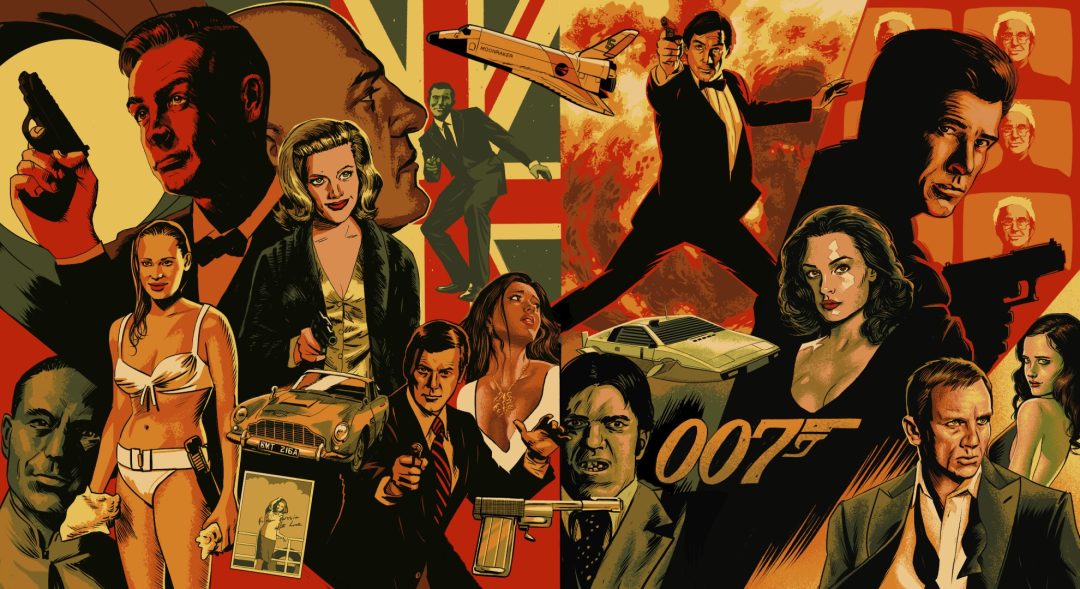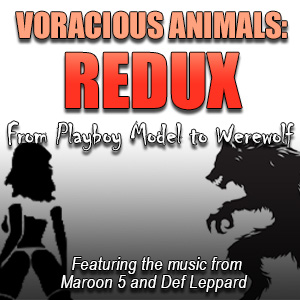Ladies, gentlemen, Outposters. Be upstanding. Sir Roger Of Moore reaches the end of his tenure as James Bond, and it is with some sadness we now find ourselves at the end of an era that probably defined Bond for many of us of a certain age. Some sadness? OK, lots of sadness. We have become rather fond of good ol’ Rog as we have been doing this, but here we are. The Battle Of The Bonds was over and one man was victorious. So it was only right that this old warrior got one more go around. It is time to say goodbye, with A View To A Kill.
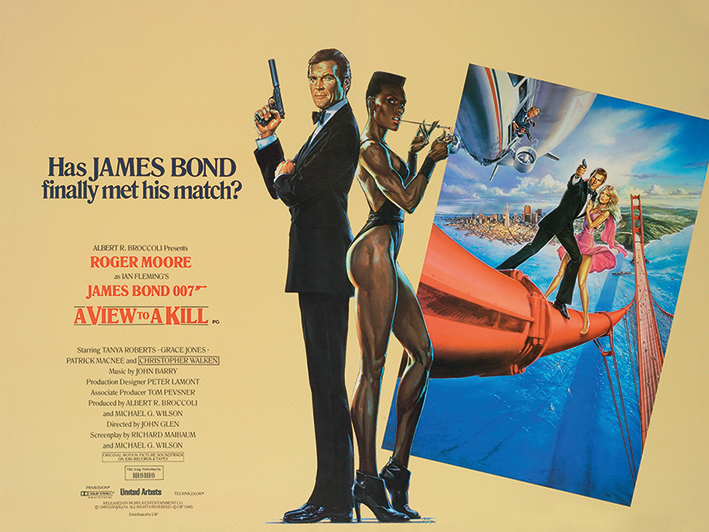
A View To A Kill – Behind The Scenes
After all of the “Will he? / Won’t he?” drama surrounding all of Roger Moore’s multiple returns to the role of James Bond, casting him in A View To A Kill was relatively easy and straightforward. They had been all set to introduce a new James Bond in the form of James Brolin for Octopussy, but the looming Battle Of The Bonds had forced them to return to their tried and tested incumbent.
Everyone assumed that Octopussy would be Moore’s last movie as 007. After he won the head-to-head with Connery, they offered him A View To A Kill. The offer on the table was a staggering $7.5 million fee. This was $2.3 million more than he received for Octopussy.
Connery had also now played 007 six times, from Dr. No through to Never Say Never Again, the same as Moore from Live And Let Die through to Octopussy. The offer on the table was a large amount of money, and the chance to be the man who had played Bond more than anyone else. How could Moore refuse? Their star was locked in, and they were good to go. Now they just needed a story.
All of the original James Bond novels by Fleming had been mined, at least for titles. After Moonraker they were out. For Your Eyes Only was the name of an anthology collection of Fleming’s 007 short stories. Octopussy was the title of one of those stories. At the end of Octopussy, the next movie was announced as From A View To A Kill – another of the short stories in the same collection. They decided to shorten it to A View To A Kill, but they still didn’t have a story.

In the short story, Bond is tracking the source of the mysterious disappearance of motorcycle couriers from Supreme Headquarters Allied Powers in Europe en route from Versailles. It is a very tight, contained story. This was not what was needed for a big-screen 007 adventure.
They stole elements of other Bond short stories, including Property Of A Lady, referenced in the Sotheby’s auction scene.
Broccoli tried to rehire George MacDonald Fraser from Octopussy to co-write the screenplay with usual collaborators Michael G. Wilson and Richard Maibaum, but he was unavailable. As usual, the writers looked to the headlines of the day for inspiration. The personal computer and technology revolution was underway, and they foresaw the time when a monopoly on microchips would make a man a king.
Veteran Bond screenwriter Richard Maibaum came up with a plot where a bad guy aimed to manipulate Haley’s Comet into crashing into Silicon Valley in California, sinking the state into the ocean and wiping out the US microchip industry. Wilson, as usual, toned things down to something more realistic. While sinking California was an evil plan in 1985, now many people might file such a notion under “reasonable” instead.
At this time in their evolution, the Bond movies were a production line, with new product arriving approximately every two years. As they were no longer directly adapting Fleming, they could see things and think:
“I wonder how we can work this into a Bond movie?”
If an idea couldn’t go into the current movie, it would be banked and dusted off as a concept for a future movie. Anyone on the cast or crew could suggest anything.
The idea for the finale came from director John Glen. He saw the Fuji blimp and asked the owners if he could get shots of them flying around the Golden Gate Bridge. Some of that footage was actually used in the film. It is why Zorin’s blimp mysteriously has a corporate color scheme suspiciously close to Fuji’s.
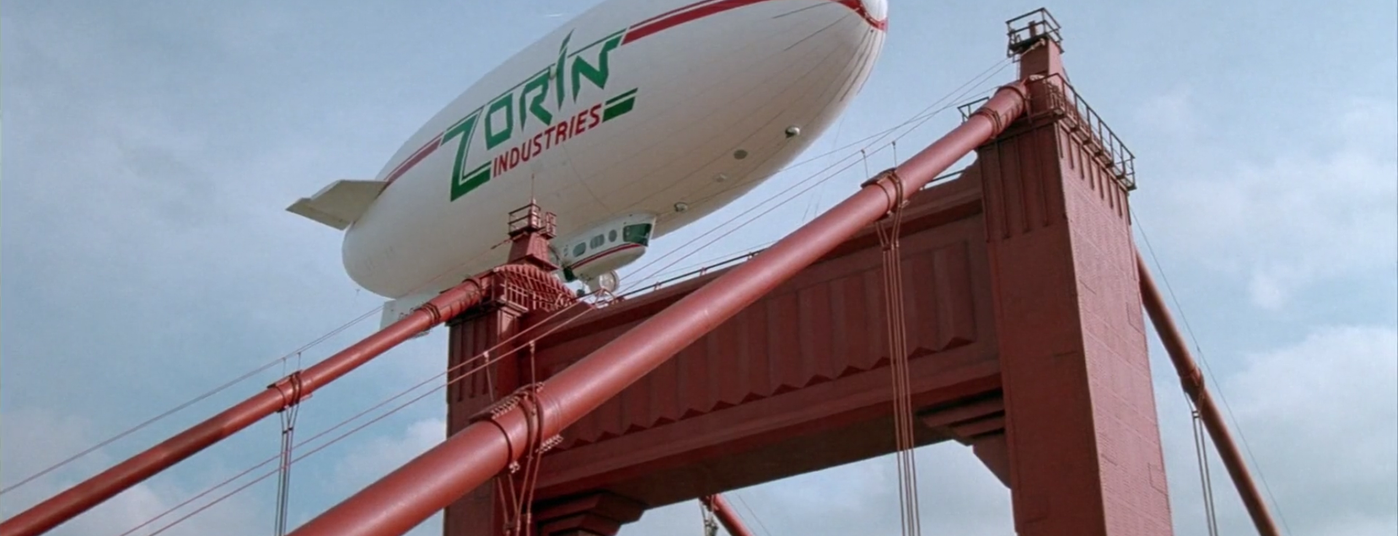
With a story in place, casting soon followed. Zorin was to be played by David Bowie. He was even announced as the villain in 1984 publicity material. He then changed his mind at the last minute as he decided:
“I didn’t want to spend five months watching my stunt double fall off cliffs.”
The part was then offered to Sting, who also turned it down. The producers had been looking at Christopher Walken as a villain for some time, due to his quirky nature. Needing a foe for 007, he was called in.
Priscilla Presley was originally going to be cast as Stacey Sutton, but she had to be replaced because of her contract with Dallas. As for Tanya Roberts, like the rest of the world, Cubby saw Beastmaster roughly 20,492 times and thought Roberts would make a great Bond girl.
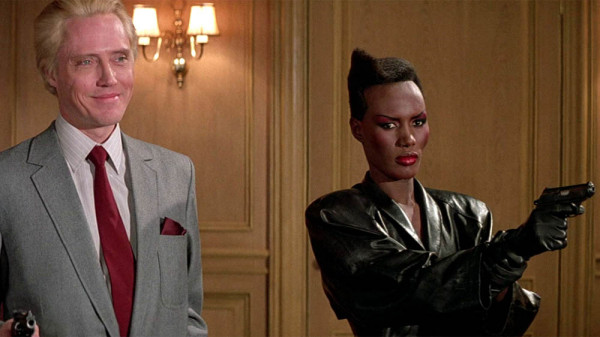
They decided to go in a different direction with the traditional henchman being a henchwoman, almost literally. When Grace Jones was cast as Mayday, she had some trepidation about her preference for aggressive makeup, but once John Glen saw it, he pleased her immensely by asking her to glam it up even further.
Barbara Broccoli suggested Patrick MacNee for his role. MacNee and Moore went way back. They were on adjacent stages during their run on The Saint and The Avengers. Originally, the role was supposed to be a former jockey. Since MacNee was too large to be a jockey, it was changed to a horse trainer instead.
The original script also had Barbara Bach reprising her role as Major Anya Amasova from 1977’s The Spy Who Loved Me. However, Bach declined to return, so an entirely new character, Pola Ivanova, was created, played by Fiona Fullerton.

Dolph Lundgren makes his screen debut as one of General Gogol’s KGB bodyguards. Lundgren was dating Grace Jones and visited her on set. On this day an extra was missing and John Glen took one look at Lundgren and asked him if he wanted to try acting.
Principal photography began with the horse racing scenes at Ascot Racecourse on 1 August 1984. A large crew then moved to Iceland to film part of the opening sequence. This was not an easy shoot. The icebergs could flip 180 degrees without much warning. In fact, crews had to quickly get off and leave equipment behind in some cases.
The radio-controlled helicopters also caused problems in the environment. They only had three. The first one had an engine that failed, and it crashed into the water. The second blew up at take-off. Fortunately, the third one did what they needed it to do to get the shots required.
For the rest of the ski sequence, they shot on the more benign Pitz Palu Glacier in Switzerland. Willie Bogner returned to film the sequence. At the time, the sport of snowboarding was practically unknown. Bogner had seen snowboarder Steve Link and was impressed enough to bring him onto the movie. So most of the world got its first-ever look at snowboarding thanks to James Bond.

Back at Pinewood, where most of the interiors were to be filmed, things hit a bit of a snag. Ridley Scott was filming Legend in the 007 Studio. A fire started due to some unsupervised flame torches and several leftover canisters of petrol. The stage was burned to the ground a week before they were due to film on it. It was a total disaster. Broccoli couldn’t even bring himself to view the remains of the building.
The crew now had a schedule issue. To compensate, they moved the San Franciso location forward while they problem solved, for now… Production Designer Peter Lamont ran into the man who helped build the 007 Stage for The Spy Who Loved Me, Michael Brown. Brown said he could have the stage rebuilt in three months, plus one month to clear the debris. Lamont went to Broccoli, who gave the go ahead to proceed.
Meanwhile, another crew was filming in Paris. Bond parachute veteran B.J. Worth and his aerial crew devised the Eiffel Tower jump. They practiced 22 jumps from a hot air balloon to perfect their timing. Michael Wilson helped with the math, as well. They figured they had about three and a half seconds before they had to pop their chute. They gauged the time by the air whistling past their ears. Once it reached a certain pitch, they knew it was time to deploy the parachute.

Getting permission for the stunt was difficult. It required 32 separate authorities at a meeting. Eventually, the stunt was approved. However, a man and woman base jumped off the tower shortly before filming and got arrested. They had heard about the Bond stunt. Authorities grew afraid that the production would inspire more people to attempt the jump and cancelled it.
After some diplomatic wrangling from the French liaison in the crew, the jump was back on.
B.J. Worth went to the top of the tower, yelled “This one’s for Cubby!” and jumped. He did it so well, they did not need a second take.
B.J.’s back up, Don Caldvedt was so disappointed he planned to do an unauthorized jump the next day. He figured he could be up, jump and be on the ground before anyone was on site. Unfortunately, he was wrong. The film crew was halfway up the tower to shoot other scenes when Caldvedt made his illegal jump. Glen actually saw him go whizzing by and was furious. The stunt was unprofessional and put the entire expensive production in danger.
B.J. Worth was forced to fire Caldvedt on the spot, and he was not allowed to work on a Bond movie again.
For the driving scenes, Remy Julienne and his team returned. It was Remy’s idea to do the jump onto the top of a bus. For the Renault taxi, still driven after being sliced in half, his crew attacked small wheels on shopping cart like mounts at the rear of the half car.
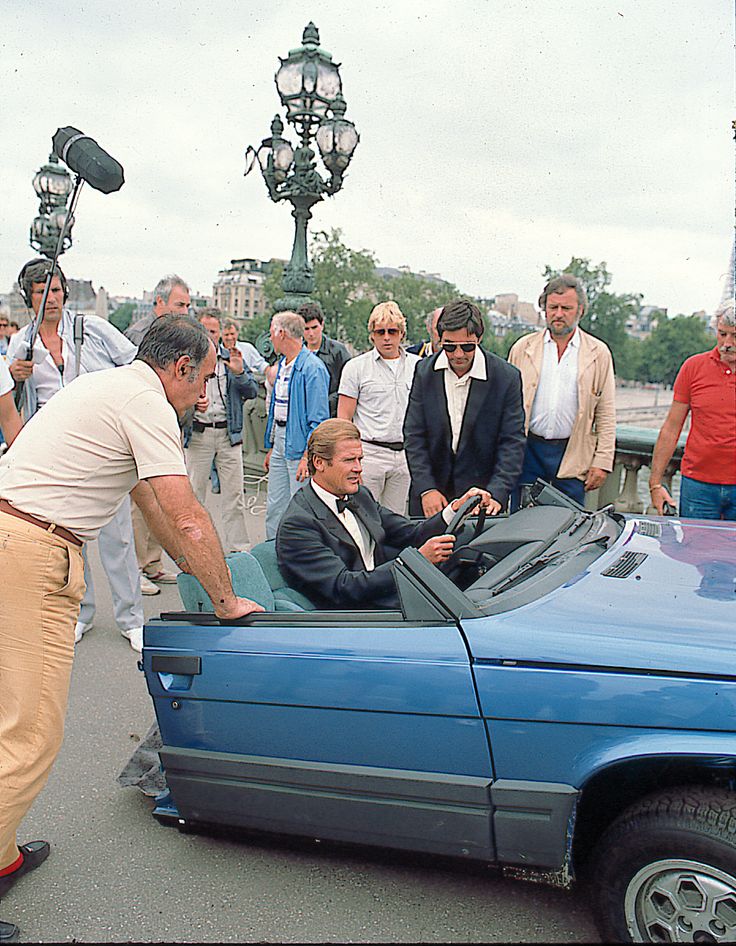
Broccoli was interested in breeding and racing horses at the time, which led to the inclusion of these themes in A View To A Kill. Zorin’s estate was shot at the Chateau de Chantilly in France that really was built by a Duke who was convinced he was going to be reincarnated as a horse, so he wanted luxurious stables. That was not made up for the movie.
The Rolls Royce Silver Cloud used at the chateau belonged to Cubby Broccoli himself. They bought another, different Rolls Royce to sink, however. Nothing but the best on a Bond film.
Shooting in San Francisco went well. The mayor welcomed the crew to the city with open arms and worked with them to make filming flow smoothly, even when they asked to set city hall on “fire,” which was achieved with smoke and flames that could be turned off with a valve. Despite smooth sailing, things could still get a bit “rough” for everyone. For example, the scene of Fiona Fullerton and Roger Moore in the jacuzzi took a full day to film. The two were in the water for eight hours and got wrinkly.
The fire engine jump was another idea of director John Glen. A real fire engine was used. They got it up to about 80 miles per hour and shattered its axles when landing.
For Bond trivia aficionados, Maud Adams makes her third appearance in a Bond movie here. She visited the set and got to be an extra in the Fisherman’s Wharf scene.

The character of Chuck Lee was originally scripted as Felix Leiter, but he was rewritten into a new Asian-American character in order to capitalize on the setting of San Francisco. David Yip was cast.
Shooting the finale required a jigsaw puzzle of real location work and studio work. Glen and company used the Fuji blimp scenes and footage of stuntmen on the actual bridge, then blended it with work completed at Pinewood on smaller stages using various techniques. A number of different scale models were used for the blimp. Some were 4:1. A twenty-foot model and a full mock-up of the gondola was also built. A full-size section of the bridge was constructed, then front projection was utilized to make the actors appear on location.
While all of this was going on, the 007 Studio was being rebuilt. It was reopened with a ceremony January 7th, 1985. It renamed the Cubby Broccoli 007 Stage in his honor and the world’s press was invited.
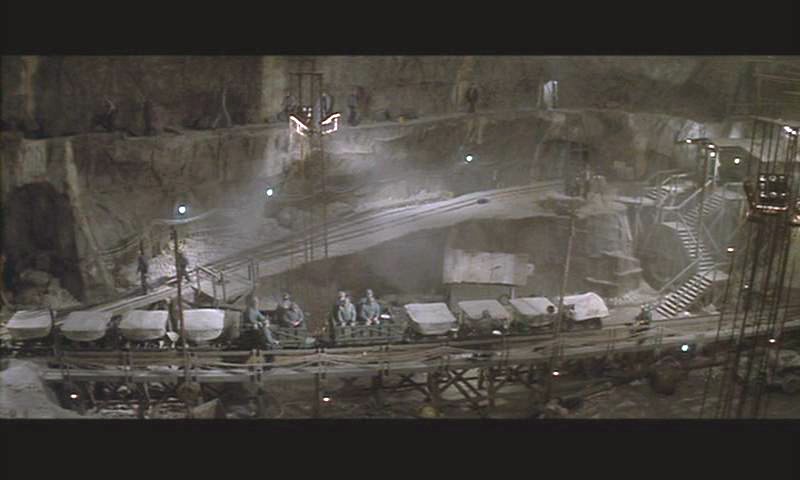
In this new, super-sized sound stage the mine scenes were then built and filmed. The flooding was accomplished with dip tanks, hoses and wires yanking stuntmen to simulate the force of the water.
Grace Jones got a fright during filming this sequence. Glen didn’t tell her that he rigged spark effects. Her reaction to them is real as she genuinely thought she could get electrocuted in the water.
Moore always knew this would be his last movie as 007. He felt they were running out of actors old enough to make believable foes, and the leading ladies were either young enough to be his daughter, or if they aged them up to the point they were starting to become Moore’s mother’s age when he started making Bond. It was time to move on. Moore was 58 when A View To A Kill came out. He didn’t bow out bitterly. He waited six months and then publically announced he was retiring from the role. Cubby had already known right from the start of production, and the search for a new 007 was well underway.
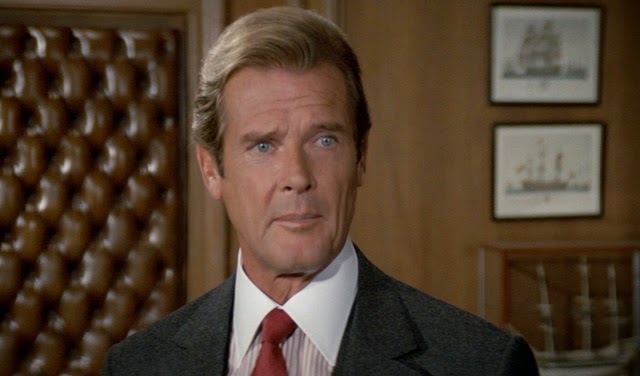
Moore said he couldn’t wait to enjoy a new Bond movie just as an audience member, and with that the era of Roger Moore came to a close.
Do You Expect Us To Talk?
Wrenage: I have a confession to make. A View To A Kill is my guiltiest-pleasure Bond. I can watch the fudge bars out of this movie and never get tired of it. So, what do you say we rate all of the elements a 10, label it the greatest Bond movie ever and knock off early?
Stark: Not so fast there, old chum. I have a reason to feel warmly about this movie too. This is the last movie I went to see in the cinema with my grandmother. Other absolute bangers I experienced with her were Indiana Jones and the Temple Of Doom, and Never Ending Story. That old girl knew how to pick ’em!
That said, nostalgia aside, this one is… not good. I mean, here we are back at the unified Bond theory again – for those that missed it, Bond is like sex and pizza, even when it’s bad it is still pretty good and you are glad you had it! – and this isn’t pushing that theory as far as Diamonds Are Forever, but it’s still in the lower tiers for me. I can already tell this one might get emotional…
Ranking And Rating
Let’s get to the ratings and rankings. Wrenage and Stark will give their opinions on the Bondian elements found in A View To A Kill and come up with a score and ranking to place them appropriately in their league table of all things Bond.
Bond
Stark: Oh Rog. Dear old Rog. He was already starting to take on a distinct middle-aged man shape in certain scenes in For Your Eyes Only. It was even more noticeable in Octopussy, but he could just about get away with it. Here… it’s gone. It’s too late. I think the word that springs to mind is “creaky” ?
Wrenage: Sharp-eyed viewers might also notice something missing from Roger Moore this go around. His fifties? Shut your mouth!
No, Moore had his facial mole removed for this film. It was a notable enough event back in the day to get commentary from Mary Hart on Entertainment Tonight. Such were more innocent times – some might say dumber times. But were they, though? People might have put Boy George at the top of the music charts, but they didn’t put him in the ladies room.
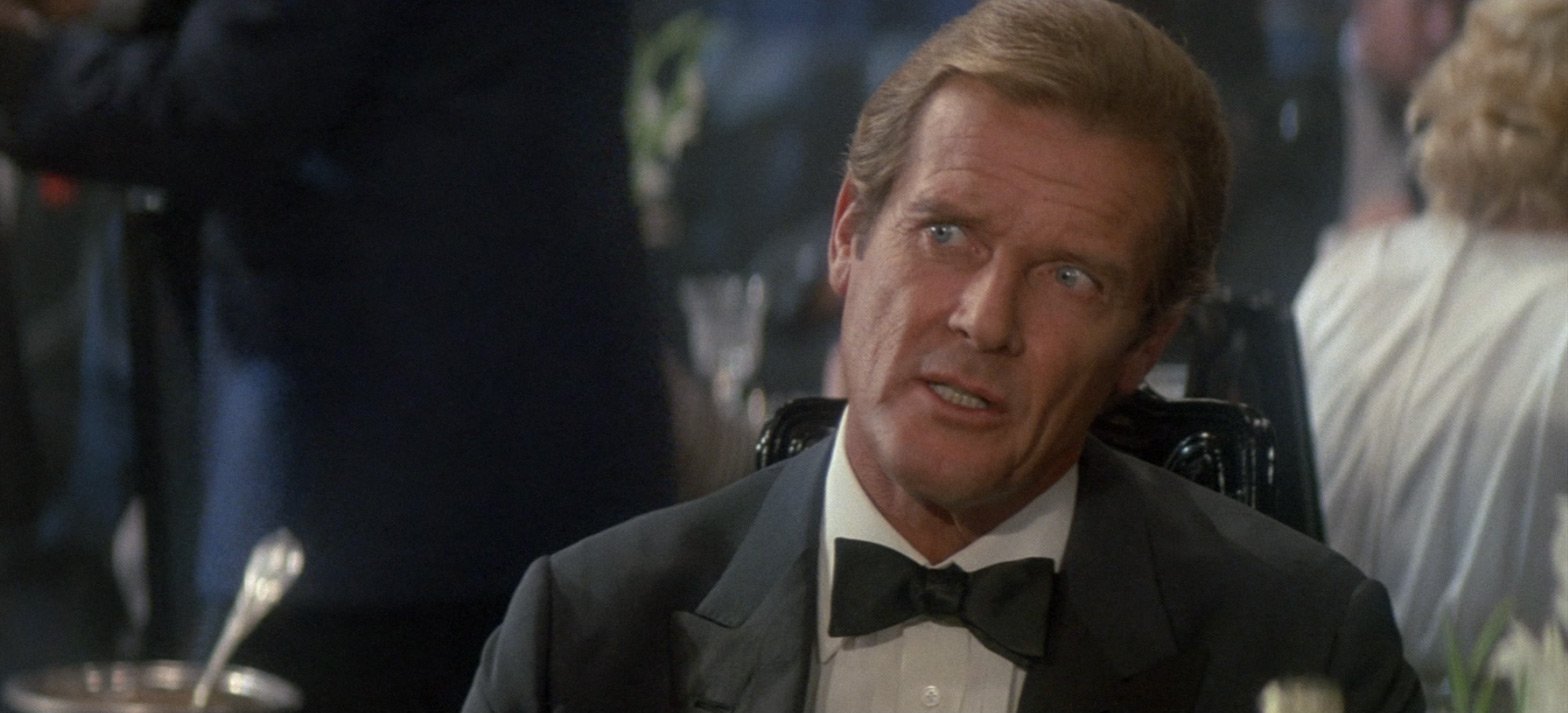
Stark: Isn’t the rumor that there was a facelift of some kind involved? I do notice how tight his leathery old skin, all St Tropez brown, looks in that bright white ski hood right at the start of the movie.
Wrenage: Facelift or not, with his handsomeness thus spruced up, Moore digs into his final outing as Bond with both arthritic hands. Moore and his stunt double team up to take down a plethora of bad guys who probably subscribe to AARP Magazine. It’s a lot of fun, though.
I especially enjoy Moore ditty-bopping about Zorin’s estate in his St. John Smyth guise while abusing MacNee, who plays Tibbet, manservant of great patience. The world missed out on something by not having this duo star in a Wooster and Jeeves movie.
Stark: I think those are my favorite scenes in the movie. Sophisticated location. Henchgirls in riding outfits. Bond doing some snooping. The interplay with Tibbet. This is where A View To A Kill works best, and where Moore’s age doesn’t work against him. Except for the Mayday bed scene where you can see the strategically pulled up bedsheets, up to Grandma level, to hide Moore’s moobs.
Wrenage: Moore had no moobs! He had MANnaries! Aside from that, Moore’s Bond gets to do a lot of fun things in A View To A Kill: ski, jump cars on buses, battle on horseback, shoot hooligans with a shotgun, swim, climb around a moving fire engine, take a rope tour of San Franciso from 800 feet and utter grave lines like, “Don’t bother, Stacey, he’s a psychopath…”
Stark: I was thinking about this just yesterday. How Bond is associated with skiing. But Connery never skied, Dalton never skied. Lazenby did (once, obviously) and Brosnan did only once. Craig also never skied. So when we think of Bond on skis, it is almost entirely the work of Moore. You just couldn’t keep Moore’s Bond off the damn slopes!
Wrenage: Is it all the greatest thing ever committed to celluloid? Yes. If you disagree, may Mary Hart arise from beneath your bed tonight and consume whatever failed and miserable hopes you still clutch to your scrawny chest.
Stark: We might have to see about getting you some kind of help…
Bond Girl
Wrenage: Tanya Roberts is a prototype of Denise Richards in The World Is Not Enough: the gorgeous scientist with an IQ of 34C. Roberts is great in A View To A Kill: sweet, tough, bumbling, and beautiful all at once.
Stark: Are you on actual drugs? That voice. The screaming. She’s not even the third-best Charlie’s Angel.
Wrenage: You shut your trash mouth! Roberts the Meryl Streep of gorgeous scientists. I fully believed her explanation of how Zorin intended to flood Silicon Valley. Admittedly, she may have been difficult to direct, though.
Okay, Tanya, in this scene you’re in the elevator shaft. It’s on fire, you’re scared and—
And I take my top off?
No, Tanya, you don’t take your top off. Bond will dangle a fire hose down and— Tanya! I said, you DON’T take your top off! Just…whatever…we’ll fix it in editing…
Stark: I must have led a sheltered life, as Beastmaster kind of passed me by, so A View To A Kill was just about all my Tanya Roberts exposure. Not even a sniff of Sheena: Queen Of The Jungle.
Wrenage: She was a pretty big deal for a bit after those movies, kind of like how Heather Thomas was a big deal for a minute or two. Poor, Tanya, though. She went from a Bond film straight into Skinemax trash. It’s too bad because she did have more to offer than sexy-bimbo energy. Roberts had a spark to her onscreen. She could have easily been a spunky version of Cybil Shepherd and thrived on a Moonlighting-type show.
Stark: Now you are just making up little Tanya Roberts career fantasies in your head, aren’t you?
Wrenage: They aren’t fantasies, if a person believes them! Meanwhile, Grace Jones does fine work as a unique combination of Bond Girl/Villain Henchman. Jones has an alien-being presence to her that commands the screen when the camera is on her. A viewer has little problem believing she is a force to reckon with, and the story gives reason for this, as well. It is implied that Mayday is a ‘roid experiment.
Stark: Scared the shit out of 11-year-old me. Now she still does, but for entirely different reasons.
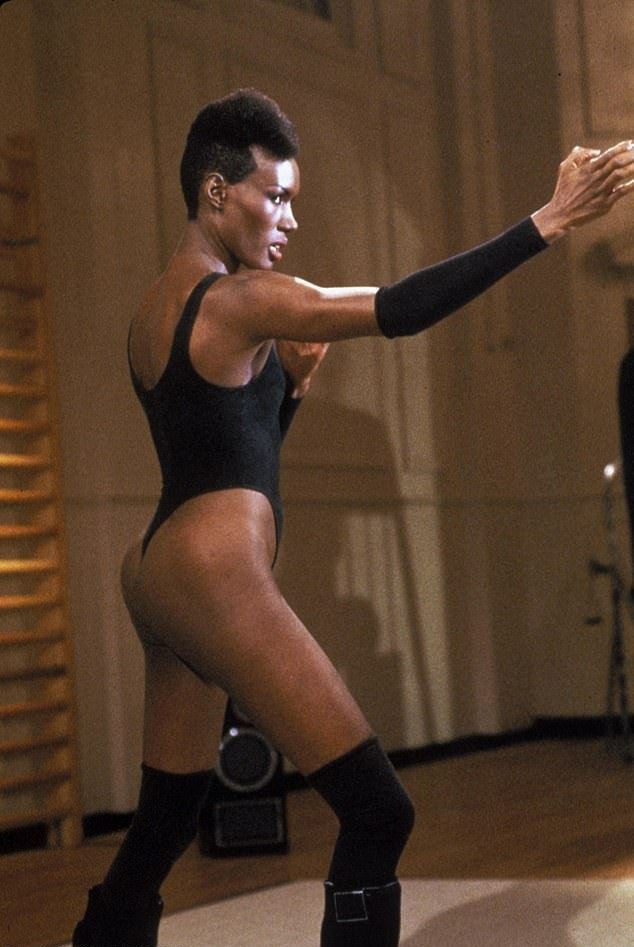
Wrenage: Filling out the Bond Girl ranks is Alison Doody in a blink-and-you-miss-it role. Doody played the leading lady in Indiana Jones and the Last Crusade. I’m still not sure why. She didn’t have the spark that Roberts had in abundance. Also, Fiona Fullerton plays a Russian agent in another brief scene. Fullerton was once married to Simon McCorkindale, Jaws III‘s greatest snack and television’s Manimal.
Stark: I recently rewatched some Manimal courtesy of the internet. You know how some things are best left in your memories…
Villains
Stark: I wonder what Bowie would have been like? Or Sting? Such was the infancy of my movie mania back in 1985 that this was really my first exposure to Christopher Walken.
Wrenage: Truth be told, I consider Christopher Walken overrated. Or maybe overexposed is a better word. The more movies Walken appears in, the more one realizes he is a one-trick pony. His one trick works great for some things, like Pulp Fiction or Prophecy. It works less great for other things, like Brainstorm.
Regardless, Walken’s trick fits nicely into the Bond universe. Zorin is a kooky, neurotic, crazy Nazi experiment with dreams of being a modern-day Taiwan in regards to microchip manufacture.
Stark: Doesn’t it seem almost quaint today? The idea of all that high-tech manufacturing actually being in California? That reminds me, they had to add a disclaimer to the movie at the start due to the Zoran Corporation in the United States affirming that Zorin was not related to any real-life company.
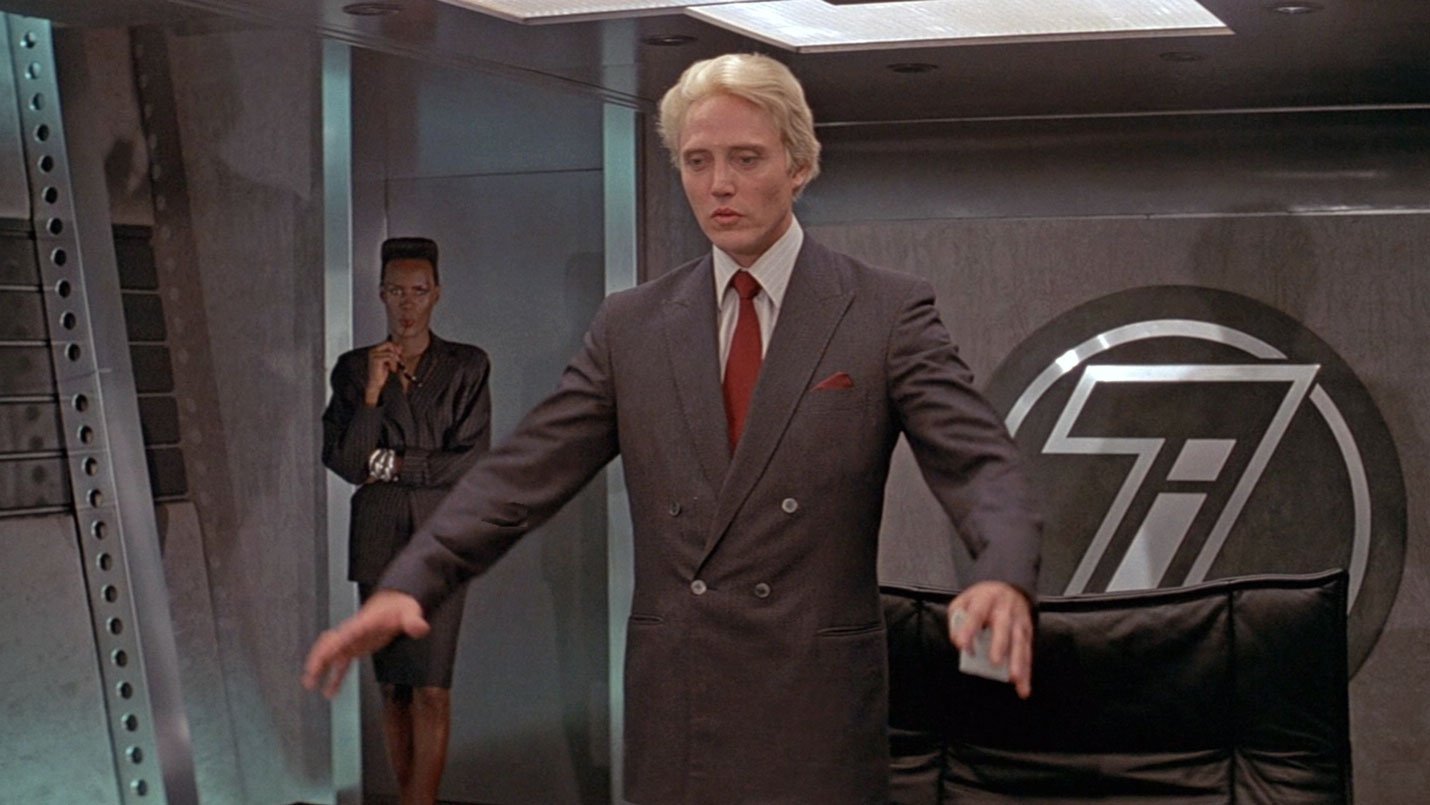
Wrenage: My favorite thing about Zorin is that he always keeps his sense of humor, even when things go awry. He also has that whole “intuitive improvisation” thing going for him. He even gets to deliver a totally Connery-style line as the villain with “Who else wants to drop out?”
Stark: There is also something incredibly cool about a guy who keeps his boardroom in a blimp.
Wrenage: Zorin’s only friend seems to be his Nazi father figure, Willoughby Gray, as Carl. Some sort of law was probably broken by not having Gray play Ebenezer Scrooge at some point in his life.
All in all, in the pantheon of Bond’s over-the-top villains, Zorin can’t dethrone Drax because a kooky American actor simply can’t compete with a French thespian condescending to a comic book role, but Walken does put in a “right on shedge-wool” performance.
Stark: Drax is the Daddy. I stand by my hypothesis that he is the best villain in one of the weakest movies. Scaramanga was in The Man With The Golden Gun… maybe I have a new Bond theory coming on. Does it track? No, it is all ruined by Blofeld in drag in Diamonds Are Forever. That fucking movie ruins everything.
Plot
Stark: A plot involving microchips was cutting edge in 1985. Zorin is a bit like Goldfinger, isn’t he? He’s cornering the market rather than destroying the world.
Wrenage: A View To A Kill skillfully walks the line between grounded and outlandish. Most of the activity is fairly realistic. If the movie sins, it sins on the side of fun rather than overly-ridiculous. A View To A Kill is also devoid of gadgets, which also helps keep at least one foot on the ground.
At the same time, Zorin’s plan is wonderfully kooky. He dreams of generating an earthquake powerful enough to sink Silicon Valley. The caper is over-the-top, certainly, but it doesn’t go to world-destroying levels like the plans of Drax and Stromberg.
Stark: It feels like a great big mixing pot of good ideas that were thrown together at points. “Right – we have microchips, so lets do a snow scene, a horse riding scene, a car chase in an American City… damn, nearly forgot the blimp!” How do you make it all go together? Who cares? In that regard, this movie does prove the adage that if you make it fun, you can paper over some pretty wide cracks.
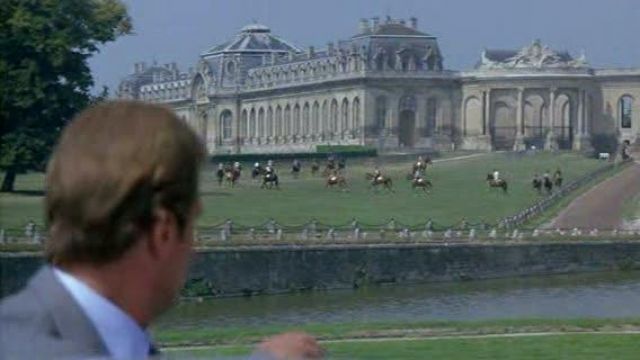
Wrenage: I also like how the screenwriters simply slapped it all together whether it makes sense or not. For example, when Bond is at the horse chateau, he goes from sneaking around a barn to a steroid lab to a microchip factory, all in one go. One doesn’t even think how odd that sequence of events is; one just shrugs and truly believes that it is perfectly natural for a 19th-century estate to have conveyor belts and robot dollies moving crates upon crates of microchips in its basement.
Stark: You mean you don’t have a horse-doping microchip factory under your stables? Now you come to mention it, that whole cheating at horseracing thing kind of disappears nearly as soon as it actually goes somewhere in the plot.
Wrenage: They should have showed Mayday shooting up roids when she cranked Bond out of the explosive pit at the end or something.
Action Sequences
Wrenage: A View To A Kill delivers bursts of satisfying, workmanlike action throughout. The action scenes are nicely spaced to keep up viewer energy, as well. Whenever the movie is on the verge of wallowing, something fun happens, whether it’s a fistfight, gunfight, car chase, or whatever. The fire engine chase almost feels a bit Spielbergian.
Stark: Workmanlike is one word for it.
Wrenage: The mine at the end is a great set piece. It makes the viewer feel like the entire Bond crew wandered into Temple of Doom briefly, and Indiana Jones is maybe beating on Pat Roach a tunnel or two away.
The highlight is the fight at the top of the Golden Gate Bridge. It’s a well-realized illusion. All of the models, miniatures, studio work, location work, and front projection cut together nicely. I don’t like heights, and a couple of shots actually give me the inklings of vertigo.
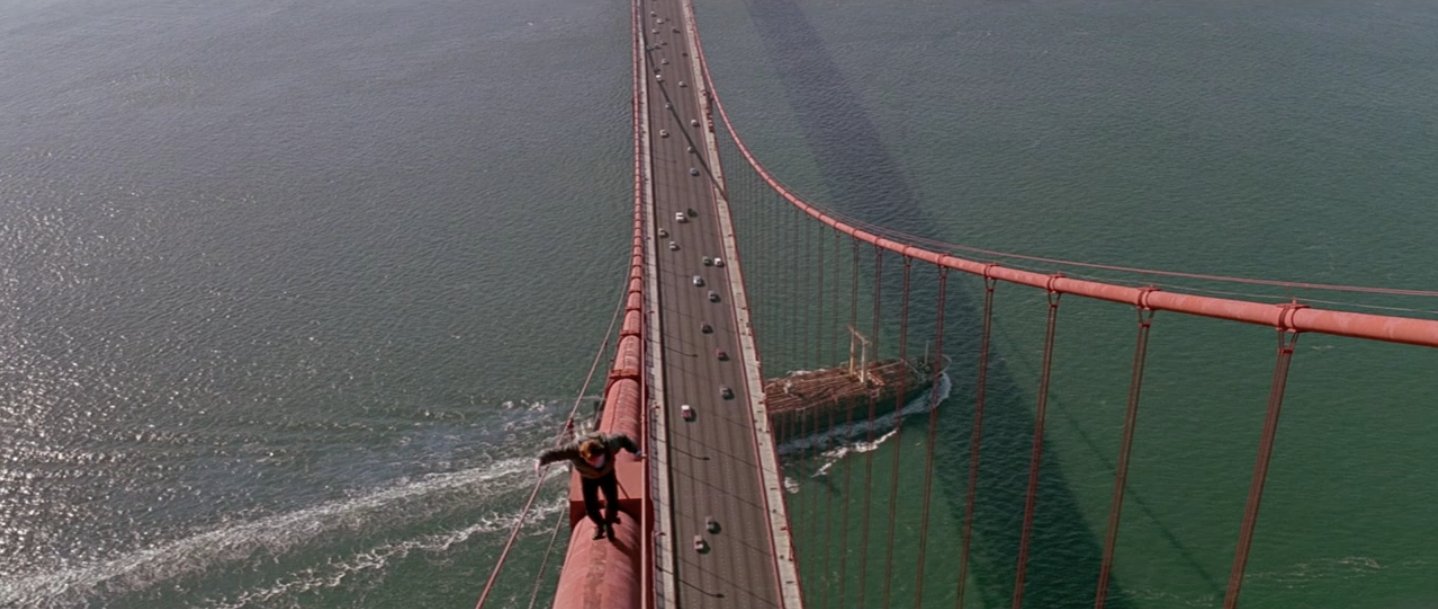
And, again, that glorious silliness returns in the climax. I like how Tanya is traipsing about the Golden Gate Bridge still in her heels. Or how Karl has his choice between a gun rack of Uzis or dynamite to kill Bond…and picks the dynamite. Sure, why not? Makes perfect sense! Go for the wildly dangerous, complicated option instead of the precision instrument!
Stark: Imagine the meetings! “…and then we are on top of the Golden Gate Bridge hanging from a blimp…” – Frankly I am staggered Tom Cruise hasn’t copied it for Mission: Impossible. When I think about this movie, from start to finish, it’s not any action scenes that stick in my mind. It’s old Uncle Roger and Stacey’s screaming. It’s the fun with Tibbet. It’s Mayday in a thong.
Pre-Title Sequence
Stark: As I said earlier, Moore’s St Tropez tan and weathered face really show up against that white ski suit. This had all the makings of a great opening sequence and then they go and ruin it. That song, it’s up there with that bloody slide whistle from The Man With The Golden Gun and that fucking pigeon out of Moonraker. Another example of when somebody needed to say “Enough!”
Wrenage: It’s always fun to see skiing in a Bond movie (except for Spectre, where it was a dirty tease). A View To A Kill is another entertaining pre-title. We get Bond on a mission. He must rarely get bored with his job. He isn’t always saving the world in casinos and tuxedos. Sometimes he is out and about recovering dead agents from snowy graves, which begs the question: does Bond go on menial assignments in between movies? Like does M ever call him in and say, “Bond, I need you to go to outpost X and monitor radio chatter between Ice Station Zebra and Firefox…”
But I digress…the location in which they shot the opening truly had rotten snow. Hailing from Minnesota, I am something of an expert on snow, and that stuff was funky. It’s the kind of snow you step in, have a solid base for an instant and then sink into over your boot, filling it with shattered-windshield size pieces of crumbling ice.

Stark: Are you like an eskimo who has hundreds of words for snow just like me, as a British person, has thousands of words for drunk? I am going to have to go back and check out this snow now, aren’t I?
Wrenage: We call the snow in the beginning of A View To A Kill, Ock- umyga-sock! Also, I don’t really want to talk about it, but we need to talk about it: the Beach Boys song. Look, it’s not a good choice. Yet, I don’t completely hate it. It’s overly-indulgent, but it’s not as bad as the slide whistle in The Man With The Golden Gun or the Tarzan yell in Octopussy. It’s fun, and it reminds me of a time when movies actively battled each other to be more fun than the last. I miss those days.
Stark: Big fan of the iceberg submarine piloted by a smoking hot lady agent. Sure, it gets a bit rapey by today’s standards at one point, but it isn’t today. It is 1985 and he is Sir Roger Of Moore!
Theme Song
Stark: One of the best. Possibly the best? When I listen to it today, I am still struck by just how good it actually is! I had this on 7″ vinyl as a wee lad. The A-side was the gun barrel, the B-side was some spent bullets. I still remember it clearly.
Wrenage: Finally, we get a break from the same old, same old that started with The Spy Who Loved Me. While all those songs are fine, none of them truly pop. A View To A Kill by Duran Duran pops. Supposedly, Duran Duran got on the film because one of them was a bit tipsy at a party, saw Cubby and went up to him and asked when he was going to get someone “good” to do the theme song.
Stark: This is true. It was bassist John Taylor, a lifelong Bond fan, who drunkenly demanded of Cubby “When are you going to get someone decent to do one of your theme songs?” In true Cubby style, he turned it around and had them doing it.
Wrenage: It has a great 80s vibe and pairs nicely with the blacklight used in the opening credits. The song is built around the theme used in the film score. The movie’s score is a sneaky good part of A View To A Kill. Barry delivers on this one. His music gives the movie a bit more credibility than it deserves.
Stark: It really, really is. Barry was on the top of his game here, and collaborated with Duran Duran on the title song. This shows. It is seamless. Bit of trivia for you, the only time the Bond theme is used in the score is during the track May Day Jumps. It is absent everywhere else but the gun barrel.
Wrenage: The score hearkens back to Barry’s work on King Kong 1976 here and there. When his music is combined with the San Francisco night scenes, I half expect to see the big ape lumbering in the background.
Stark: Also the only Bond theme to hit #1 on the Billboard charts, and won a Golden Globe for Best Original Song.
X-Factor
Stark: I feel we will be miles apart on this, what with your unabashed love for this entry.
Wrenage: Admittedly, there are not a lot of X-Factor exists at this point in Moore’s run. Everything is a bit by-the-numbers at this stage.
Stark: The again, maybe not.
Wrenage: We do get the hapless-policeman character returning. He hasn’t really graced the screen since Diamonds Are Forever, Live and Let Die, and The Man With The Golden Gun. The hapless policeman in this instance is played by Joe Flood. They humor he is exploited for is a bit broad, but it is combined with a plethora of crashing police cars, which make it more palatable.
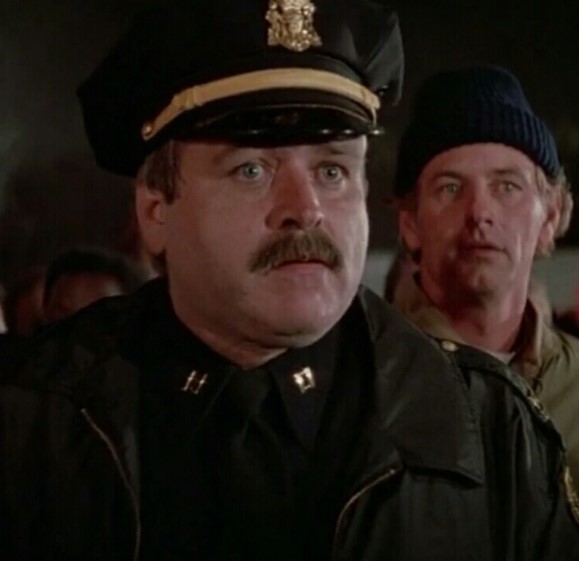
Stark: That is just what the rest of the world thinks American cops are. There is some humor but it’s not too over the top… other than that bloody Beach Boys song. What were they thinking?
Wrenage: Overall, the goofy humor that could plague Moore’s Bond films is present in A View To A Kill, but it is taken down a notch from Octopussy, at least. Daniel Benzali also pops in. His character in The X-Files was always so angry and nasty that it is strange to see him in a plain, nice-guy role here.
Scoring Breakdown
| Stark | Wrenage | |
| Bond | 6 | 7 |
| Bond Girl | 4 | 7 |
| Villain | 6 | 7 |
| Plot | 6 | 7 |
| Action Sequences | 5 | 7 |
| Pre-Title Sequence | 5 | 7 |
| Theme Song | 9 | 8 |
| X-Factor | 3 | 2 |
| TOTAL | 44 | 53 |
Stark: Moore loses a mark here due to his decrepitness. Which is mad when you think about it. He was 57. Then again, 57 in 1985 years is about 71 in 2024 years. The theme tune smashes it in the scoring. X-factor is lacking. The rest of it scores a resounding shrug.
Wrenage: That reminds me. I know a way to assuage your angst at Dr. No’s continual descent. Remember it got an “N/A” from you on song and an “N/A” from me on pre-title, so is is missing a chunk of points.
It was hard for me not to score A View To A Kill a “10” in all categories, but I must not let personal feelings, or, as some may call it, the truth, to carry the day. I must attempt to get inside the head of people who fear to experience genius filmmaking, or simply don’t understand it, and rate the movie from their perspective.
Stark: I feel a Dr. No recount coming on now I have been reminded of this information!
Overall Rankings
Recently we saw For Your Eyes Only push The Man With The Golden Gun down a tier, then Octopussy pushed down Moonraker. Lots of movement going on in that middle tier. We also put Never Say Never Again in, just that one time, to see where it landed. It was in tier 3. Now let us “never” speak of it again.
So where does A View To A Kill rank?
First Tier:
From Russia With Love (61.5)
On Her Majesty’s Secret Service (61)
The Spy Who Loved Me (59.5)
Goldfinger (54.5)
Thunderball (53.1)
Second Tier:
Live and Let Die (53)
You Only Live Twice (51.5)
For Your Eyes Only (51.5)
Octopussy (51)
Dr. No (49.5)
Third Tier:
Moonraker (48.5)
A View To A Kill (48)
The Man With The Golden Gun (38.5)
Diamonds Are Forever (34.5)
Fourth Tier:
(Empty)
That’s A Wrap
Stark: Not gonna lie. I am sad. Really, really sad. Moore isn’t my favorite Bond and his movies aren’t my favorite Bond movies, but he was MY Bond, dammit! I was born in the 70s so I discovered Bond with him and grew up with him as Bond. In the same way Tom Baker will always be MY Doctor Who.
Going back and revisiting his movies, I find a lot to like, and upon analyzing them I have enjoyed them very much. Maybe found some new appreciation for them. And now it is over. We will never see Rog again.
Wrenage: The era of Roger Moore was a fun ride. I freely admit Moore wasn’t the best Bond, and when I think of the most excellent of the Bond movies, I don’t think of any of Moore’s first, but he was my favorite Bond at the end of the day. He is effortlessly breezy, and you never got the sense that he grew weary of fans or lamented the great burden of being a star. Moore seemed to genuinely appreciate the role.
Stark: Let’s say goodbye to Roger Moore the way he deserves. With an excellent re-cut trailer of this final adventure.
NEXT TIME… The age of Moore has ended. The era of Dalton begins, as we prepare to scare The Living Daylights out of you.
Meanwhile, check out the rest of our Bond On series as we take a walk through all the Bond movies in order: Dr. No, From Russia With Love, Goldfinger, Thunderball, You Only Live Twice, On Her Majesty’s Secret Service, Diamonds Are Forever, Live And Let Die, The Man With The Golden Gun, The Spy Who Loved Me, Moonraker, For Your Eyes Only. and the two-way Battle Of The Bonds that was Octopussy and Never Say Never Again.
Check back every day for movie news and reviews at the Last Movie Outpost



